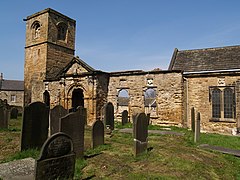Wentworth Estate, Yorkshire
| Wentworth | |
|---|---|
 Old Holy Trinity Church, Wentworth |
|
| Wentworth shown within South Yorkshire | |
| Population | 1,478 (2011) |
| OS grid reference | SK385985 |
| Civil parish |
|
| District | |
| Shire county | |
| Region | |
| Country | England |
| Sovereign state | United Kingdom |
| Post town | ROTHERHAM |
| Postcode district | S62 |
| Dialling code | 01226 |
| Police | South Yorkshire |
| Fire | South Yorkshire |
| Ambulance | Yorkshire |
| EU Parliament | Yorkshire and the Humber |
| UK Parliament | |
Wentworth is a village and civil parish in the Metropolitan Borough of Rotherham in South Yorkshire, England.
In the 2001 Census the village had a population of 1,223, increasing to 1,478 at the 2011 Census.
The civil parish includes the village of Harley on the B6090 road to the west of the main settlement.
The village's history is dominated by the Wentworth, Watson-Wentworth and Wentworth-Fitzwilliam families who lived in Wentworth Woodhouse. They also owned perhaps most of the land in the village. Wentworth gained some independence when the Fitzwilliam family line ended in 1979.
The village dates back to at least 1066, when, according to the Domesday book, Rynold Wynterwade was lord of the manor. About 1250 Robert Wentworth married Emma Woodhouse, beginning the Wentworth-Woodhouse line; the family lived in the area for over 450 years. The lands then passed to the Watson family when William Wentworth, 2nd Earl of Strafford died without heir; the Watsons held the land until 1782. During this time most of the local follies were built. The Fitzwilliam ownership ended in 1979 when William Thomas George Wentworth-Fitzwilliam, 10th Earl Fitzwilliam died.
The Old Holy Trinity Church, the village's first church was a chapel of ease to All Saints Church, Wath Upon Dearne. Like its successor it was the principal place of worship on the estate, dedicated to the Holy Trinity, and is thought to date to the 12th century. The new church, Holy Trinity Parish Church, was commissioned in 1872 by the 6th Earl Fitzwilliam to the design of John Loughborough Pearson, an exponent of the Gothic Revival style, and was consecrated in 1877 by the Archbishop of York.
...
Wikipedia

